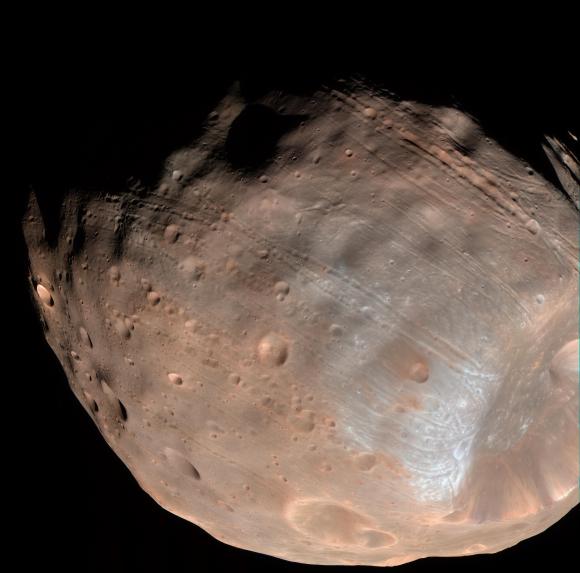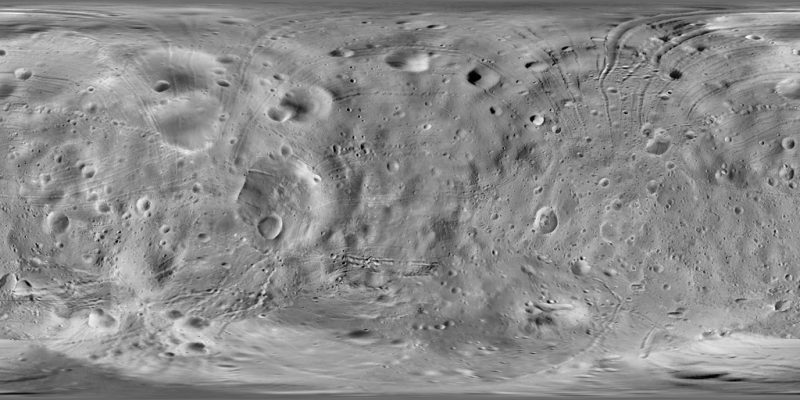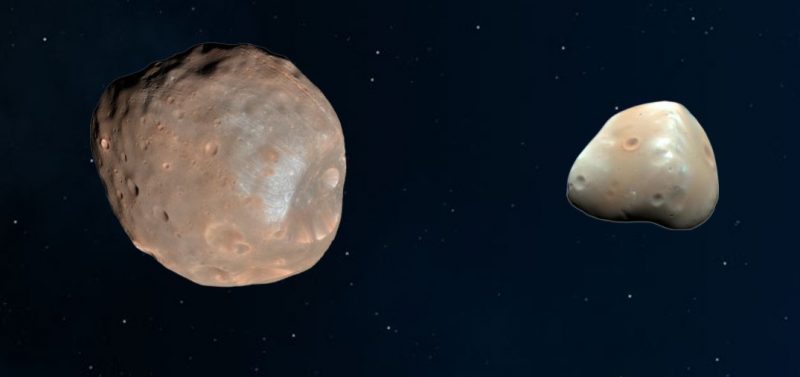August 17, 1877: Asaph Hall discovers Phobos
On August 17, 147 years ago, American astronomer Asaph Hall discovered the first known moon for our neighboring planet, Mars. Later that year, he found a second Martian moon. Today, we call the first and larger moon Phobos. And we call the second and smaller one Deimos.
To date, Phobos and Deimos remain the only known moons of Mars.
Both Phobos and Deimos are potato-shaped. They look more like asteroids than like Earth’s much-larger companion moon. In fact, it’s likely that Mars captured these little worlds that now orbit the red planet. Studies have indicated that – millions of years from now – Phobos will shatter and form a ring around Mars. Some astronomers think Phobos alternates between being a planetary ring, then clumping up again to form a moon. More about ring theories of Phobos below.
Phobos and Deimos, fear and terror
The names Phobos and Deimos mean fear and terror, respectively. They’re named for the mythological horses that pulled the chariot of the Greek war god Ares. He was the Greek counterpart to the Roman war god Mars.
So, although it’s the larger of Mars’ two moons, Phobos is tiny. It has a mean diameter of only about 14 miles (22.2 km). But it’s seven times more massive than Deimos, which has a mean diameter of about 7.7 miles (12.4 km). For these moons, we’re speaking in terms of a mean diameter because both moons are oblong in shape and not spherical. In contrast, Earth’s moon is nearly round, since it’s large enough for its gravity to have pulled it into a spherical shape.
Earth’s moon is also much larger (2,159 miles or 3,475 km in diameter). Since both Phobos and Deimos are so tiny, they have very weak gravity. And that means they don’t have enough gravity to make them round.
Mariner 9 was 1st to see them close
During Mariner 9’s mission to Mars in 1971 and 1972, scientists got their first close-up look at Phobos. Just like asteroids, its oblong surface shows many small craters. But one large crater stood out as much bigger than the rest. Astronomers named it Stickney Crater, for Angeline Stickney – an an American academic, suffragist and mathematician – and Asaph Hall’s wife.
Stickney looks like a giant hole on one end of Phobos. Whatever rocky body created it was almost big enough to have shattered the moon. It’s thought that, whenever the impact occurred, Phobos barely survived.



Was Phobos once a ring? Will it be again?
Phobos has long, shallow grooves running across its surface, radiating away from Stickney. Many planetary scientists believe these grooves are early signs of eventual structural failure in the moon. They say it’s possible that – some 50 million years from now – Phobos will break apart, forming a ring around Mars.
A study in 2018 suggested that rolling boulders created the grooves, spraying across the surface during impact. As Ken Ramsley, a planetary science researcher at Brown University who led the work, explained:
These grooves are a distinctive feature of Phobos, and planetary scientists have been debating how they formed for 40 years. We think this study is another step toward zeroing in on an explanation.
More ring theories
In 2017, a new theory by Purdue University scientists suggested Phobos might not only break apart and form a ring around the planet but also suggests this ring formation happened before.
David Minton, a professor, and Andrew Hesselbrock, a doctoral student, both at Purdue, developed a computer model showing debris ejected into space from an asteroid or other body slamming into Mars. This event – some 4.3 billion years ago – would cause the material to now alternate between becoming a planetary ring and clumping up again to form the moon Phobos.

Daily Owl #Fact
One day #Mars will have a ring around it?
In the next 20-40 million years Mars’ largest moon Phobos will be torn apart by gravitational forces leading to the creation of a ring that could last up to 100 million years#NFTs #Moon #Space pic.twitter.com/IIYHCkgDhf
— MarsBirds? (@mars_birds) July 12, 2022
Deimos played a role
Another study, from scientists at Purdue and the SETI Institute in June 2020, also concluded that Mars used to have a ring or series of rings. The scientists based that study on an analysis of the orbit of the other Martian moon, Deimos.
Deimos is smaller than Phobos. And it has an orbit that’s tilted with respect to Mars’ equator by about 2 degrees. Meanwhile, Phobos’ orbit isn’t inclined as much. The larger moon is inclined to Mars’ equator by only about 1 degree. The scientists said in a statement:
These orbital resonances are picky but predictable … We can tell that only an outward-moving moon could have strongly affected Deimos, which means that Mars must have had a ring pushing the inner moon outward … This moon may have been 20 times as massive as Phobos, and may have been its ‘grandparent’ existing just over 3 billion years ago … [It] was followed by two more ring-moon cycles, with the latest moon being Phobos.
So, basically, there may have been a moon about 20 times more massive than Phobos, and Mars’ rings pushed it outward. And at least two times since then, that moon broke apart and then formed a new ring, before the material coalesced together again to form a new moon. Phobos is now that current moon.The scientists say it will eventually break apart to form a new ring, thus continuing the cycle.
Scientists also now know Phobos is much younger than Deimos – perhaps only 200 million years old – which would fit the moon/ring scenario. The Phobos we see today is simply a newer and smaller version of its original self.
Eclipsing moons
Asaph Hall probably never imagined the idea of Phobos breaking apart and forming a ring around Mars. And he couldn’t possibly have imagined the video below, which was acquired by NASA’s Mars rover Curiosity on August 1, 2013. This video shows both moons, Phobos and Deimos, as you might see them while standing on the surface of Mars. You can clearly see some of the large craters on Phobos in these images.
This was the first time that images taken from Mars’ surface caught one moon eclipsing the other … but probably not the last.
Bottom line: On August 17, 1877, American astronomer Asaph Hall discovered Phobos, the larger of the two Martian moons. He discovered Deimos later that year.